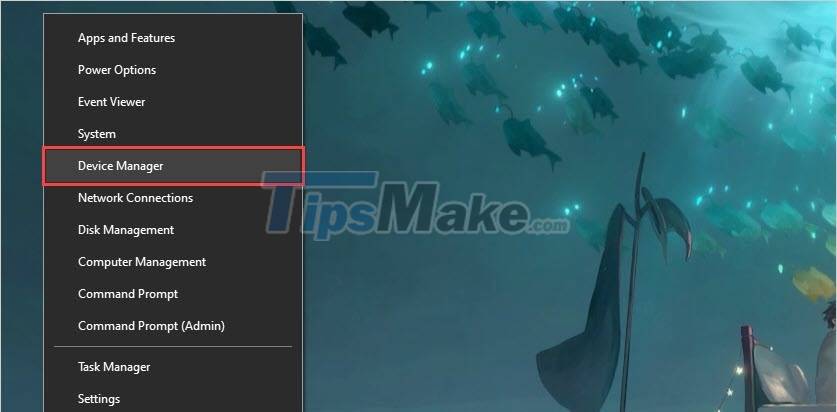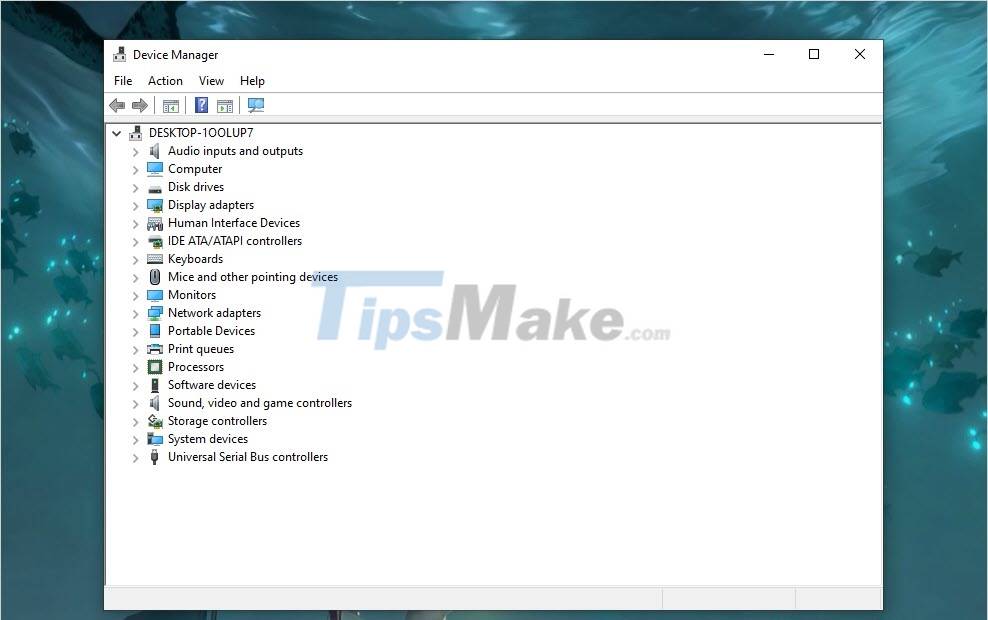Steps to open Device Manager on Windows
There are many different ways to access Device Manager on Windows. In this article, Software Tips will guide you to open Device Manager in 4 most common ways.
Method 1: Open Device Manager via Start Menu
Start Menu can quickly activate several features on Windows and that includes Device Manager. To open the Device Manager feature, do the following:
Right-click MenuStart and select Device Manager.

Immediately, Device Manager will appear for you to use.

Method 2: Open Device Manager through This PC
This PC is the desktop icon available on Windows 10 and they can open a lot of different tools!
Step 1: First, right-click This PC and select Manage.

Step 2: When the Computer Management window appears, select Device Manager. Here, you can use the full features of Device Manager.

Method 3: Open Device Manager through the Run window
Besides the usual ways to open Device Manager, you can also choose to open Device Manager through the relatively more complicated Run window.
Step 1: First, open MenuStart and enter Run to open or press Windows + R to open.

Step 2: When the Windows window appears, enter hdwwiz.cpl and click OK to open Device Manager.

Method 4: Open Device Manager directly on Start Menu
The last way to open that Software Tips wants to send to you is the way to open it directly on MenuStart, similar to other software.
You proceed to open the Start Menu, enter Device Manager and press Enter.

The Device Manager window will appear with all the content for you to use.

In this article, Tipsmake showed you how to quickly open Device Manager on a Windows computer. Have a nice day!
You should read it
- How to find lost Android devices using Android Device Manager
- How to Open Device Manager in Windows
- What is Windows Device Manager? How to use it?
- How to use Device Manager to troubleshoot Windows 10
- All problems about using Task Manager
- How to fix 'Base System Device' error in Device Manager
- Device Association Framework Provider What is a Host and why is it running on a computer?
- How to fix the NVIDIA graphics card error is not displayed in Device Manager
May be interested
- Ways to open Task Manager on Windows 10
 ways to open task manager on windows 10. task manager is the most effective computer management tool for you to make changes to the running applications. because of the importance of task manager, the developer has equipped you with many different ways to start task manager.
ways to open task manager on windows 10. task manager is the most effective computer management tool for you to make changes to the running applications. because of the importance of task manager, the developer has equipped you with many different ways to start task manager. - Ways to enable Task Manager in Windows 11
 in windows 11, task manager has received a number of improvements, both in appearance and features. for example, if ever, windows users in general have a habit of launching task manager by right-clicking on the taskbar and selecting the corresponding option.
in windows 11, task manager has received a number of improvements, both in appearance and features. for example, if ever, windows users in general have a habit of launching task manager by right-clicking on the taskbar and selecting the corresponding option. - Device Association Framework Provider What is a Host and why is it running on a computer?
 every time you open task manager on a windows 8 or windows 10 computer, you will see a lot of processes called 'device association framework provider host' running. what is 'device association framework provider host'? and why this process is running on your windows computer. is this a virus? all answers will be in the following article of network administrator.
every time you open task manager on a windows 8 or windows 10 computer, you will see a lot of processes called 'device association framework provider host' running. what is 'device association framework provider host'? and why this process is running on your windows computer. is this a virus? all answers will be in the following article of network administrator. - How to open Task Manager, introduce the functions in Task Manager
 how to open task manager, introduce the functions in task manager. true to its name, task manager is a tool that helps us manage all the active tasks in windows. however, task manager not only has that feature, it also has children
how to open task manager, introduce the functions in task manager. true to its name, task manager is a tool that helps us manage all the active tasks in windows. however, task manager not only has that feature, it also has children - How to keep Windows Task Manager open a specific tab
 while using task manager to monitor your windows 10 pc, you sometimes use one tab (e.g. 'performance') more often than others. in that case, you can set that tab as the one you see when you start task manager.
while using task manager to monitor your windows 10 pc, you sometimes use one tab (e.g. 'performance') more often than others. in that case, you can set that tab as the one you see when you start task manager. - Quickly download new drivers through Device Manager on Windows 10
 on windows 10, drivers are needed for your device to connect with other devices and the operating system. windows 10 provides a series of default generic drivers for monitors (displays), wireless connections such as bluetooth, keyboards, mice, and other manufacturer-installed hardware.
on windows 10, drivers are needed for your device to connect with other devices and the operating system. windows 10 provides a series of default generic drivers for monitors (displays), wireless connections such as bluetooth, keyboards, mice, and other manufacturer-installed hardware. - 7 fastest ways to open Task Manager on Windows
 task manager helps you to kill frozen applications and check cpu, ram on windows. if you can't open it in the usual way, try shortcuts, cmd or run for quick access.
task manager helps you to kill frozen applications and check cpu, ram on windows. if you can't open it in the usual way, try shortcuts, cmd or run for quick access. - How to find lost Android devices using Android Device Manager
 android device manager is an android device management application that helps you locate your smartphone if lost.
android device manager is an android device management application that helps you locate your smartphone if lost. - Steps to fix Bluetooth error not in Device Manager
 the fact that bluetooth cannot connect to the computer causes many obstacles for users. if you don't know how to fix bluetooth error not in device manager, click to see now!
the fact that bluetooth cannot connect to the computer causes many obstacles for users. if you don't know how to fix bluetooth error not in device manager, click to see now! - Instructions to fix Task Manager has been Disabled by your Administrator
 task manager error has been disabled by your administrator which appears quite often, especially on windows xp until the next windows versions, from vista, then windows 7, then 8 and 8.1. when you press the shortcut combination ctrl + alt + delete or right-click on the taskbar, the task manager option is dimmed, or display an error message ...
task manager error has been disabled by your administrator which appears quite often, especially on windows xp until the next windows versions, from vista, then windows 7, then 8 and 8.1. when you press the shortcut combination ctrl + alt + delete or right-click on the taskbar, the task manager option is dimmed, or display an error message ...










 Learn about Superfetch (Sysmain) process on Windows
Learn about Superfetch (Sysmain) process on Windows 5 common reasons why Windows update fails
5 common reasons why Windows update fails How to use the 'Do Not Disturb' feature to turn off notifications on Chromebooks
How to use the 'Do Not Disturb' feature to turn off notifications on Chromebooks Steps to play full screen games on Windows 7, 8, 10
Steps to play full screen games on Windows 7, 8, 10 How to use DISM to copy and restore images FFU
How to use DISM to copy and restore images FFU Will the performance of big.LITTLE x86 CPUs increase significantly on Windows 11?
Will the performance of big.LITTLE x86 CPUs increase significantly on Windows 11?